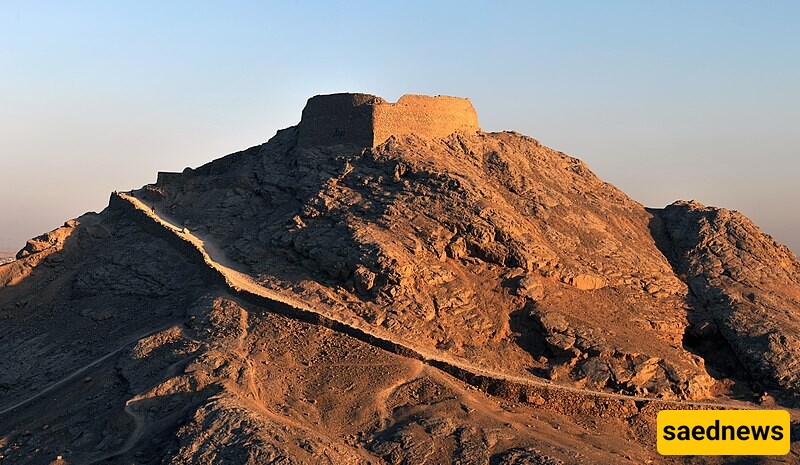SAEDNEWS: The Tower of Silence in Yazd, Iran, stands as a powerful symbol of ancient Zoroastrian burial customs. Built on a stark hilltop, it once hosted open-air funerals where the deceased were returned to nature. Today, it remains a solemn and fascinating destination for those drawn to its historic significance.

According to SAEDNEWS, Set against the austere landscape of Yazd, the Tower of Silence, or “Dakhma,” is one of the last remaining structures that embodies ancient Zoroastrian burial customs.
Positioned on top of a desolate hill, the tower appears as a solitary, circular stone enclosure that once served as a sacred place for a unique funeral practice. For Zoroastrians, protecting the purity of nature was paramount, and burial practices were no exception. The tower was designed to provide a respectful, ecological way to release the body back to nature without contaminating the sacred elements of earth, fire, and water.

The Zoroastrian faith, founded by the prophet Zoroaster over three thousand years ago, is based on the concept of a dualistic struggle between good and evil, with a deep respect for the natural world. Zoroastrians believe that the deceased body becomes impure as it is overtaken by evil spirits upon death. To prevent the defilement of sacred elements, burial and cremation were strictly avoided. Instead, the dead were transported to dakhmas, where the cycle of life would continue through sky burial. By placing the bodies atop these towers, exposed to scavenger birds, the deceased would gradually return to the earth in a way that aligned with Zoroastrian ethics.
Yazd’s Tower of Silence is one of the last-standing relics of this tradition, offering a glimpse into the values that guided the Zoroastrian community. The structure is plain yet significant: a large circular stone platform surrounded by high walls for privacy and reverence. Inside, bodies were laid out in concentric circles—men on the outer ring, women in the middle, and children in the center—allowing nature to take its course in a respectful and dignified manner.
The process of preparing the deceased for the dakhma was meticulously guided by priests known as nasellars. Clad in white, they were responsible for cleansing and carrying out rites, ensuring the sanctity of the tower was upheld. The nasellars were highly respected figures who carefully managed this sacred process, which also included specific prayers and symbolic gestures. In Yazd, this process of sky burial continued until the twentieth century when new health regulations brought an end to the practice.
Today, visitors can ascend the same hill that generations of Zoroastrians once climbed, experiencing the solemnity that defined these ancient rites. Walking along the hill’s path, the isolation and silence offer a glimpse of the tranquility that must have surrounded each burial, a quiet respect for the Zoroastrian tradition and their reverence for life’s passage.
The Tower of Silence remains a key part of Zoroastrian heritage in Yazd. Although the practice of sky burial has been discontinued, the tower stands as a powerful reminder of the ancient rituals and values that shaped the region’s cultural fabric. Visitors who journey to this site are often struck by the serene, haunting beauty of the surrounding desert, with the Tower of Silence watching over the city of Yazd below. Local guides are available to share knowledge about the tower’s origins, Zoroastrianism’s ancient tenets, and how Yazd became a hub for Iran’s Zoroastrian community.
Just a short distance away, the Zoroastrian Fire Temple provides another glimpse into this enduring faith. Here, a sacred flame that has burned for over one thousand five hundred years symbolizes purity and continuity, linking the present-day Zoroastrian community to their ancestral beliefs. Together, the fire temple and the Tower of Silence are two powerful sites that convey Zoroastrianism’s reverence for nature and the cycles of life.
The Tower of Silence is accessible to travelers who wish to understand this part of Iran’s cultural and spiritual history. Visitors are asked to respect the site, appreciating its significance for Zoroastrians and observing the solemn atmosphere that still lingers. The tower’s simplicity—its weathered stone walls, barren hilltop, and views of the vast desert—draws people into contemplation about life, death, and the unique customs that have shaped our world. As one leaves the tower, the surrounding landscape and the quiet solitude leave a lasting impression. Standing at this site, visitors are reminded of the human search for meaning in life and respect for nature that transcends time.
The Tower of Silence in Yazd offers a rare window into the ancient rituals of Zoroastrianism. More than a historical site, it is a place of profound respect for nature, reflecting humanity’s bond with the environment and spiritual traditions. For travelers, this unique landmark serves as a reminder of the continuity between past and present, urging us to honor the ancient values that connect us to the natural world.

